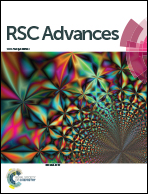Multiple-engineering controlled growth of tunable-bandgap perovskite nanowires for high performance photodetectors†
Abstract
Controllable growth of perovskite nanowires is very important for various applications in optical and electrical devices. Although significant progress has been achieved in the solution method, a deep understanding of the mechanics of growing perovskite nanowires is still lacking. Herein, we developed an electrochemical method for growing the perovskite nanowires and studied the growth processes systematically. The initial nucleation and crystal growth could be controlled by simply varying the additive solvents, thus leading to two stable size ratio distributions of the perovskite nanowires. Further, with compositional engineering, the bandgap of the perovskites could be tuned from 1.59 eV to 3.04 eV. All the as-grown perovskite nanowires displayed a unique structure with high crystallization quality, contributing to a very high responsivity of 2.1 A W−1 and a large on/off ratio of 5 × 103 for the photodetectors based on the CH3NH3PbBr3 nanowires. All of these findings demonstrate that the optimized solution method offers a new approach to synthesize perovskite nanowires for applications in photoelectric devices.



 Please wait while we load your content...
Please wait while we load your content...